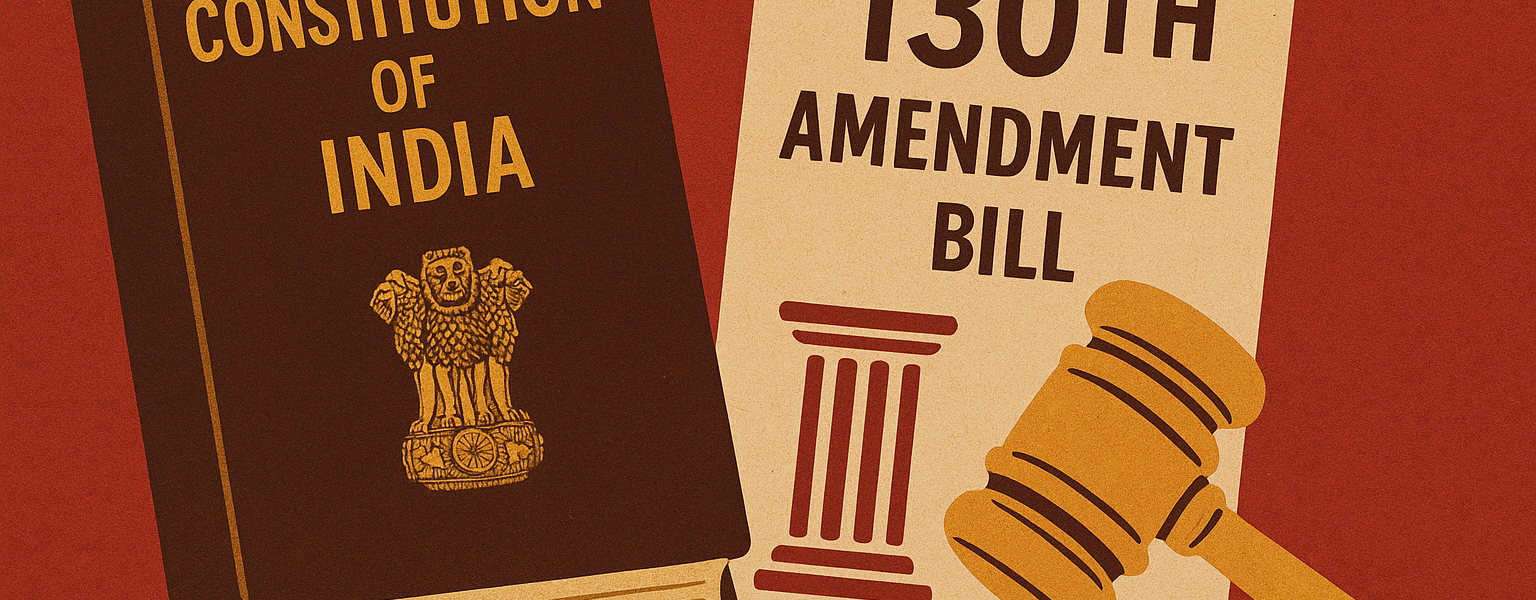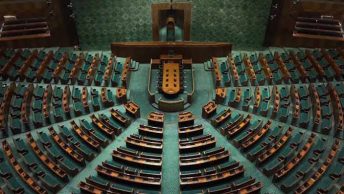Recently, the Indian government introduced the 130th Constitutional (Amendment) Bill, 2025 (“the Bill”). Serious concerns have been raised regarding the Bill and the probable misuse of its provisions (see here). In this essay, I characterize the Bill as a “constitutional hardball” and argue that, although the concerns regarding the bill merit serious engagement, it would be astonishingly difficult to find faults with the bill constitutionally and to argue for its invalidity before a constitutional court.
Why the Bill is a Constitutional Hardball?
Professor Mark Tushnet defines a ‘constitutional hardball’ as “political claims and practices—legislative and executive initiatives—that are without much question within the bounds of existing constitutional doctrine and practice but that are nonetheless in some tension with existing pre–constitutional understandings.” In essence, ‘constitutional hardball’ refers to an initiative that pushes against long-standing norms, conventions, or expectation of fair play, without technically breaking the law. The 130th Amendment Bill is a classic example of a constitutional hardball, and nor is this the first attempt at constitutional hardballing by the BJP Government. In fact, the BJP rule in India has been marked by an approach of ‘autocratic legalism’ — this Bill is just another brick in the wall.
The intended objective of the Bill is seemingly noble: to uphold “constitutional morality and principles of good governance” by providing for removal of ministers who face serious criminal charges and are arrested. The political context in which this Bill has been introduced, in particular the recent cases and arrests of various chief ministers and state ministers belonging to parties other than the BJP, has already been discussed here. This political context alone is sufficient to raise suspicions about the intent of the government behind bringing this amendment.
However, once the Bill is passed by the legislature (a difficult but not impossible scenario) and becomes an Amendment, the underlying motivations behind bringing the amendment become irrelevant, since post-enactment, the Amendment could be tested only in a constitutional court on strictly constitutional grounds. As a matter of principle, a constitutional court dealing with the question of the validity of an amendment does not concern itself with the motivations or policy considerations behind the amendment.
Furthermore, since this is a constitutional amendment, the only way to establish its invalidity is through establishing that it violates the Basic Structure of the Indian Constitution—which, in this case, seems to be a herculean task. Although what constitutes basic structure of the constitution is not clearly laid down, and Basic Structure itself has evolving contours, but some principles have been identified through successive case laws by the Indian Supreme Court. Inter alia, the following facets of the constitution’s basic structure come into play in context of this Bill: rule of law, separation of powers, federalism, parliamentary democracy.
However, given the stated object of the amendment, it would be difficult to argue that the amendment violates rule of law (interpreted to be a part of the basic structure in Indira Nehru Gandhi v. Raj Narain), since despite its effect of turning the criminal law doctrine of “innocent until proven guilty” on its head, the minister in question does not lose his ministership permanently, nor does it have any effect on his membership of the legislature. Although Justice Chandru has sought to demonstrate, by relying on the ratio of the judgement in Lily Thomas v. Union of India, how the Bill is blatantly illegal and in contravention of the Law Commission’s conclusions (see here), a willing court could turn the Rule of Law Argument upside down and go on to hold that the amendment in fact strengthens the rule of law by ensuring that those accused of serious criminal offences do not continue to exercise executive power as ministers. It is important to note that the judgement in Lily Thomas dealt with an ordinary statute, i.e. the Representation of People’s Act, which is tested against violation of Fundamental Rights, whereas here the Court would be concerned with an amendment to the Constitution itself where violation of basic structure must be demonstrated clearly to successfully challenge the amendment.
Similarly, even a challenge on the grounds of violation of the federal scheme (a basic structure according to the SC’s judgement in S R Bommai v. Union of India), is likely to fail since the power to remove the chief minister (“CM”) or the state ministers is vested in the Governor who, although appointed by the President, is part of the State’s Executive (see Article 153 and 154 of the Indian Constitution). More particularly, Article 164(1) categorically states that the CM and other ministers are appointed by the Governor and “shall hold office during the pleasure of the Governor,” a phrase that, according to the Calcutta High Court, vests discretion in the governor which is “absolute and unrestricted” and “cannot be called into question” before a constitutional court. Therefore, in light of this provision, adding another provision that allows the Governor to remove a minister who has been accused of a serious criminal offence may not be said to be violative of the basic structure, in particular the federal scheme. However it must be noted that it is a well-respected constitutional convention, albeit not an explicit rule, that the Governor does not remove a Chief Minister until he loses the confidence of the House (for example, even in the recent Maharashtra Legislative Assembly Case, Uddhav Thackeray was not removed but resigned himself before a floor test could be conducted). This Bill, in granting the Governor this power to remove, which could be justified on the basis of the “pleasure of the governor doctrine” is a terrific instance of constitutional hardballing.
However, this argument too can be turned on its head: it can be possibly also argued that the new provisions interfere with the governor’s discretion under Article 164(1), since it is mandatory and not directory in nature, and thereby effectively allows the Central Government to dictate the terms of removal of a state minister rather than the Governor of that state whose prerogative it so far has been. However, even if the Court agrees that it is an interference with the Governor’s discretion, it is unlikely to hold that such interference violates the basic structure. The court may hold that this is not an interference with the governor’s discretion, but carving out of a specific circumstance where his discretion could be limited by the constitution itself, since this is after all an amendment of the constitution and not any ordinary legislation.
However, there is one element of basic structure—and one core argument—that could perhaps tilt the scale in favor of a holding that the amendment is unconstitutional. That is parliamentary democracy (which has been held to be a basic structure in multiple cases, including Kesavananda Bharati v. State of Kerala and Kihoto Hollohon v. Zachillhu).
Parliamentary Democracy: Hail Mary of this Constitutional Challenge
I categorize parliamentary democracy as ‘Hail Mary’ after the name of the move in Rugby that is a desperate, and often unsuccessful, last-ditch effort that just might work. Mounting a challenge to this Bill on the basis of the basic structure element of parliamentary democracy is, in my opinion, one such attempt. The argument could be that parliamentary democracy, in particular the Westminster Model, has been held to be a basic structure of the constitution. With that in mind, it is settled law—and a respected constitutional convention—that the Governor of a state dismisses other ministers in accordance with the advice of the Chief Minister.
Although the outlier judgements by Calcutta High Court in Mahabir Prasad Sharma v. PC Ghosh and by the Gauhati High Court in Jogendranath Hazarika v. State of Assam allowed the governor to dismiss even the chief minister, ordinarily a chief minister is only removed if he loses the confidence of the House of the Legislature. Insofar as the Bill provides for a mandatory removal of the Prime Minister by the President and the Chief Minister by the Governor, it could be contended to be violative of the core tenets of the Westminster-style parliamentary democracy by allowing a leader who commands the confidence of the House to be removed at the behest of the President or the Governor, as the case may be.
Interestingly, in Democratic Congress and Others v. Puseletso and Others, a recent case from Lesotho, the Court of Appeal even invalidated an amendment to the constitution that provided that if the prime minister loses confidence of the House he only has one option, i.e. to resign, and cannot call for a fresh election. The Court of Appeal held this to be violative of the core tenets of the Westminster-style democracy and therefore the Basic Structure of the Lesotho Constitution.
In India, if this amendment takes effect, we face a much graver situation where a leader has not even lost the confidence of the House but is forcefully removed from his office due to an unsubstantiated and unproven criminal charge. This certainly offends the core tenets of the Westminster-style parliamentary democracy, which is a tenet of the basic structure of the constitution of India. Therefore, an Indian constitutional court hearing the challenge against this amendment may follow the precedent from Lesotho’s Court of Appeal and hold that a mandatory removal, where the individual commands the confidence of the House, is not in accordance with the principles of the Westminster-style democracy and violates the basic structure of the Constitution for this reason.
Even if the court does not invalidate the whole amendment but invalidates the specific provision that allows removal of the Chief Ministers and the Prime Minister, many political concerns could be relieved, since any misuse of the provision would likely be directed towards the PM or the CM, who is considered to be the leaders of the government, and the removal of the PM or the CM puts a government in a more precarious position that the removal of any other minister would. Thus, even if the provisions with respect to the PM and the CM are invalidated, it would be a considerable victory for parliamentary democracy in India. However, as mentioned, the argument is ‘hail mary’ since for this the Court would have to return three clear inferential findings: (i) that Westminster-style democracy is a Basic Structure of the Constitution, (ii) that it is a fundamental tenet of the Westminster-style democracy that the prime minister (or chief minister) should enjoy the confidence of the House and can only be removed from his executive position if he loses the confidence of the House, and (iii) the impugned provisions in this Bill violate that fundamental tenet and therefore violate the basic structure of the constitution.
Conclusion
The Bill is still in a nascent form and some changes could be expected through deliberations. This essay has attempted to fast-forward and analyze how a constitutional challenge may be mounted, if the bill is indeed passed by the legislature and becomes an amendment. The concern that the amendment would not be invalidated is real, since the drafting of the bill and the stated objective is shrewd and legally tenable. Moreover, even though India has adopted the basic structure doctrine (or unconstitutional constitutional amendments doctrine), Indian courts have shown great reluctance in invalidating constitutional amendments. This is apparent from the fact that only seven amendments so far have been struck down (partly or wholly) by the court as unconstitutional on the grounds of the violation of Basic Structure, and incidentally all seven of the amendments in some way or the other infringed the judiciary’s own institutional interests, either by way of prohibiting judicial review or interfering with the process appointment of judges (99th Amendment). Thus, in light of the experience of the Indian Supreme Court’s treatment of challenges to constitutional amendments, it would not be wrong to expect the court to uphold this amendment.
Masoom Sanyal is a final year law student at Gujarat National Law University. He is keenly interested in Indian and comparative constitutional law.
[Ed Note: The piece is edited by Hamza Khan and published by Vedang Chouhan]







I do agree with all the ideas you have introduced on your post They are very convincing and will definitely work Still the posts are very short for newbies May just you please prolong them a little from subsequent time Thank you for the post
Your writing has a way of making even the most complex topics accessible and engaging. I’m constantly impressed by your ability to distill complicated concepts into easy-to-understand language.
obviously like your website but you need to test the spelling on quite a few of your posts Several of them are rife with spelling problems and I to find it very troublesome to inform the reality on the other hand Ill certainly come back again
I do believe all the ideas youve presented for your post They are really convincing and will certainly work Nonetheless the posts are too short for novices May just you please lengthen them a little from subsequent time Thanks for the post
Your blog is a breath of fresh air in the often mundane world of online content. Your unique perspective and engaging writing style never fail to leave a lasting impression. Thank you for sharing your insights with us.
Thanks I have just been looking for information about this subject for a long time and yours is the best Ive discovered till now However what in regards to the bottom line Are you certain in regards to the supply
https://galindoslowriderbikes.com/product/20-inch-lowrider-tricycle/
best Istanbul tours Well-planned tours with no hiccups. https://opg-sudic.hr/?p=14419
Your blog is a treasure trove of valuable insights and thought-provoking commentary. Your dedication to your craft is evident in every word you write. Keep up the fantastic work!
Your writing is like a breath of fresh air in the often stale world of online content. Your unique perspective and engaging style set you apart from the crowd. Thank you for sharing your talents with us.
https://globalketo.com/2018-jeju-south-korea
Nice blog here Also your site loads up fast What host are you using Can I get your affiliate link to your host I wish my web site loaded up as quickly as yours lol
Fantastic beat I would like to apprentice while you amend your web site how could i subscribe for a blog site The account helped me a acceptable deal I had been a little bit acquainted of this your broadcast offered bright clear concept
https://lossanddamageforum.org/unheard-echoes-from-the-south
I was suggested this web site by my cousin Im not sure whether this post is written by him as no one else know such detailed about my trouble You are incredible Thanks
Somebody essentially lend a hand to make significantly posts I might state That is the very first time I frequented your web page and up to now I surprised with the research you made to create this particular put up amazing Excellent job
Your blog is a treasure trove of valuable insights and thought-provoking commentary. Your dedication to your craft is evident in every word you write. Keep up the fantastic work!
Its like you read my mind You appear to know so much about this like you wrote the book in it or something I think that you can do with a few pics to drive the message home a little bit but other than that this is fantastic blog A great read Ill certainly be back
Sakıp Sabancı Museum tour I loved the storytelling aspect of the tour. https://rw13sekeloa.com/?p=2915
What i do not understood is in truth how you are not actually a lot more smartlyliked than you may be now You are very intelligent You realize therefore significantly in the case of this topic produced me individually imagine it from numerous numerous angles Its like men and women dont seem to be fascinated until it is one thing to do with Woman gaga Your own stuffs nice All the time care for it up